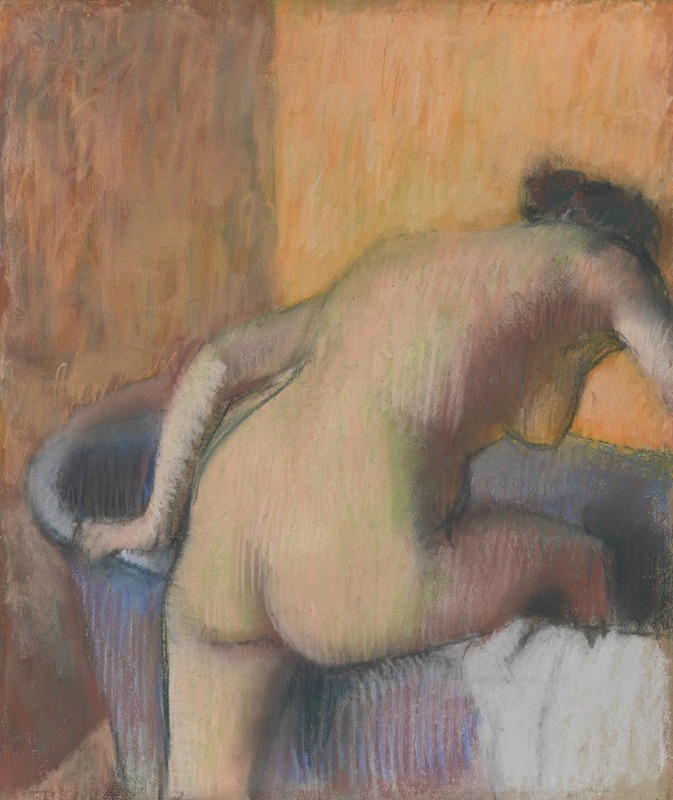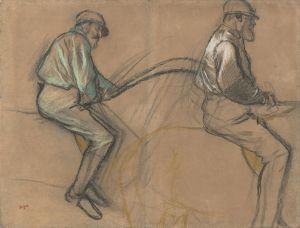
Bather Stepping into a Tub
A hand-painted replica of Edgar Degas’s masterpiece Bather Stepping into a Tub, meticulously crafted by professional artists to capture the true essence of the original. Each piece is created with museum-quality canvas and rare mineral pigments, carefully painted by experienced artists with delicate brushstrokes and rich, layered colors to perfectly recreate the texture of the original artwork. Unlike machine-printed reproductions, this hand-painted version brings the painting to life, infused with the artist’s emotions and skill in every stroke. Whether for personal collection or home decoration, it instantly elevates the artistic atmosphere of any space.
Edgar Degas, a prominent French artist associated with the Impressionist movement, is renowned for his innovative approach to capturing the human form, particularly in moments of movement and intimacy. One of his notable works, "Bather Stepping into a Tub," exemplifies his fascination with the theme of women in private, everyday activities. This pastel drawing, created around 1886, is part of a series of works by Degas that explore the subject of women bathing.
"Bather Stepping into a Tub" is a pastel on paper, a medium Degas frequently employed in his later years. The work depicts a woman in the act of stepping into a bathtub, a moment of vulnerability and grace. Degas's choice of subject reflects his interest in capturing candid, unguarded moments, offering a glimpse into the private lives of his subjects. The composition is intimate, with the viewer positioned as if peering into a private space, a common characteristic of Degas's bathers series.
The pastel medium allows for a soft, delicate rendering of the scene, with Degas employing a subtle palette of colors to convey the warmth and texture of the woman's skin and the surrounding environment. The use of light and shadow is masterful, highlighting the contours of the woman's body and the gentle ripples of water in the tub. Degas's technique in this work demonstrates his skill in capturing the play of light on different surfaces, a hallmark of his artistic style.
Degas's bathers series, including "Bather Stepping into a Tub," is notable for its departure from traditional representations of the nude. Rather than idealizing the female form, Degas presents his subjects in natural, unposed states, emphasizing their individuality and humanity. This approach was innovative for its time, challenging conventional notions of beauty and the portrayal of women in art.
The context of Degas's work is also significant. During the late 19th century, the depiction of women in private, domestic settings was a subject of both artistic interest and societal debate. Degas's bathers can be seen as part of a broader exploration of modern life, capturing the tension between public and private spheres. His work offers insight into the changing roles and perceptions of women during this period, reflecting broader cultural shifts.
"Bather Stepping into a Tub" is housed in the Hill-Stead Museum in Farmington, Connecticut, part of a collection that includes several other works by Degas. The museum's collection was assembled by Alfred Atmore Pope, an American industrialist and art collector, and his daughter, Theodate Pope Riddle, an architect and philanthropist. Their collection reflects a keen interest in Impressionist art, and Degas's work is a highlight of their holdings.
In summary, "Bather Stepping into a Tub" is a quintessential example of Edgar Degas's exploration of the human form and the intimate moments of everyday life. Through his innovative use of pastel and his focus on candid, unidealized depictions of women, Degas offers a unique perspective on the themes of privacy, beauty, and modernity. His work continues to be celebrated for its technical mastery and its insightful portrayal of the complexities of human experience.


















